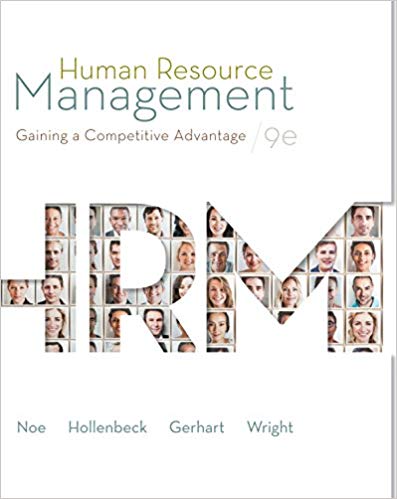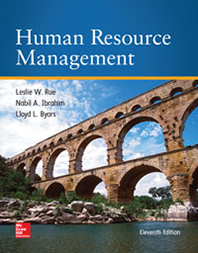Description
Human Resource Management Gaining A Competitive Advantage 9th Edition Noe, Hollenbeck, Gerhart, Wright TB
006
Student: ___________________________________________________________________________
1.
Much of the work in personnel selection involves measuring the characteristics of people to determine who will be accepted for job openings.
True False
2.
The degree to which a measure is free from random error refers to its reliability.
True False
3.
Reliability refers to the measuring instrument rather than to the characteristic itself.
True False
4.
The correlation coefficient is zero for a perfect positive relationship.
True False
5.
Validity is the extent to which performance on the measure is related to performance on the job.
True False
6.
A measure can be valid without being reliable.
True False
7.
A concurrent validation assesses the validity of a test by administering it to people already on the job and then correlating test scores with existing measures of each person’s performance.
True False
8.
The size of the sample on which the correlation is based has no role in achieving statistical significance.
True False
9.
Content validity is achieved primarily through a process of expert judgment.
True False
10.
The inability to use content validation in small sample settings makes it generally less applicable than criterion-related validation.
True False
11.
Reliability is defined as the degree to which the validity of a selection method established in one context extends to other contexts.
True False
12.
Validity is necessary but not sufficient for generalizability.
True False
13.
The more reliable, valid, and generalizable a selection method is, the more utility it will have.
True False
14.
The utility of any given test generally increases as the selection ratio gets higher.
True False
15.
The Civil Rights Act of 1991 protects individuals from discrimination based on race, sex, religion, and national origin with respect to hiring as well as compensation and working conditions.
True False
16.
As per the Age Discrimination in Employment Act, the burden of proof always lies with the person who faces discrimination.
True False
17.
The Americans with Disabilities Act of 1991 protects individuals with physical disabilities, but not those with mental disabilities.
True False
18.
Compliance of executive orders is monitored by the Office of Federal Contract Compliance Programs.
True False
19.
Experience-based items ask what the person is likely to do when confronting a certain hypothetical situation in the future.
True False
20.
A physical ability test measures balance but not coordination.
True False
21.
Employees with high conscientiousness tend to be lethargic and ill-disciplined.
True False
22.
Work-sample tests are not job-specific and their generalizability is high.
True False
23.
The Polygraph Act in 1988 permitted the use of polygraphs in employment screening.
True False
24.
A large-scale independent review of validity studies suggests that paper-and-pencil honesty tests cannot predict both theft and other disruptive behaviors.
True False
25.
One of the concerns regarding the use of drug tests in a workplace is the undue invasion of privacy.
True False
26.
_____ is defined as the degree to which a measure is free from random error.
A.
Reliability
B.
Validity
C.
Generalizability
D.
Utility
E.
Correlation
27.
Which of the following statements is true of the reliability of a measurement?
A.
A measurement is said to be reliable when only two iterations are involved in measurement.
B.
Reliability refers to the measuring instrument rather than to the characteristic itself.
C.
It is not dependent on the attributes of the measuring instruments used.
D.
Reliability indicates the degree to which two objects are related to each other.
E.
It indicates the extent to which performance on the measure is related to performance on the job.
28.
The _____ is a measure of the degree to which two sets of numbers are related.
A.
utility score
B.
standard deviation
C.
correlation coefficient
D.
validity score
E.
generalizability coefficient
29.
Which of the following correlation coefficients indicates a perfect positive relationship?
A.
+1.0
B.
-1.0
C.
0
D.
+10
E.
-6.67
30.
Which of the following correlation coefficients indicates a perfect negative relationship?
A.
-10
B.
-6.67
C.
+1.0
D.
-1.0
E.
0.0
31.
When assessing the reliability of a measure, one might be interested in knowing how scores on the measure at one time relate to scores on the same measure at another time. This is called:
A.
test-interdependency.
B.
test-retest reliability.
C.
mutual exclusivity.
D.
test utility.
E.
test generalizability.
32.
Which of the following steps can help an organization increase the reliability of its interview process?
A.
Using a single interviewer instead of multiple interviewers
B.
Basing tests on the people who are already working
C.
Providing raters with standardized training
D.
Avoiding the use of common formats to rate candidates
E.
Basing tests on people who were most successful in earlier interviews
33.
The extent to which performance on the measure is related to performance on the job is called:
A.
reliability.
B.
validity.
C.
generalizability.
D.
utility.
E.
authenticity.
34.
Which of the following statements is true regarding reliability and validity?
A.
Reliability and validity are directly proportional to each other.
B.
Reliability and validity are inversely proportional to each other.
C.
The reliability of a measure is essential for it to have any validity.
D.
Reliability and validity are independent of each other.
E.
Reliability is a necessary and sufficient condition for validity.
35.
If there is a substantial correlation between test scores and job-performance scores, _____ validity has been established.
A.
criterion-related
B.
content
C.
construct
D.
procedural
E.
subject
36.
_____ validation is a validity study that seeks to establish an empirical relationship between test scores taken prior to being hired and eventual performance on the job.
A.
Content
B.
Predictive
C.
Concurrent
D.
Subjective
E.
Logical
37.
Which of the following is the most accurate definition of concurrent validity?
A.
It is an estimate of whether a validity test appears to measure a certain criterion.
B.
It is performed by demonstrating that the questions or problems in a validity test are representative of situations at work.
C.
It assesses the validity of a test by administering it to people already on the job and then correlating test scores with existing measures of each person’s performance.
D.
It seeks to establish an empirical relationship between test scores taken prior to being hired and eventual performance on the job.
E.
It refers to the degree to which a measure is correlated with other measures that it is theoretically predicted to correlate.
38.
Star Inc., an engineering firm, has come up with a new technical test to assess the knowledge of interviewees. To assess the validity of the test, it requests its present employees to take the test and match it with their performance in the organization. Which of the following types of validation has Star Inc. used to test the validity of its new technical test?
A.
Predictive validation
B.
Content validation
C.
Concurrent validation
D.
Face validation
E.
Logical validation
39.
Predictive validation is superior to concurrent validation because:
A.
predictive valuation involves contributions from many individuals.
B.
job applicants often have no information about organizational culture.
C.
job applicants are more motivated than an organization’s employees.
D.
the effort needed for predictive valuation is lesser than concurrent valuation.
E.
the time taken for predictive valuation is lesser than concurrent valuation.





Be the first to review “Human Resource Management Gaining A Competitive Advantage 9th Edition Noe, Hollenbeck, Gerhart, Wright Test Bank”